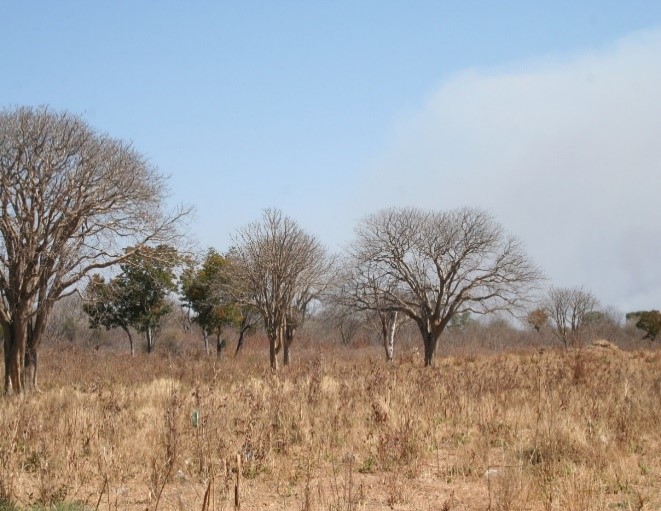Manketti / Mongongo Seed Oil
- High nutritive value and has traditionally been used as a natural “sun screen” – protecting the skin against desert sun and offers protection against environmental damage
- Offers a nutrient-rich hair treatment oil. Because of its unique composition, forms a protective film over hair without making it oily
- Can be used in a wide variety of creams, lotions, sun care products, lip balms, hair conditioning oils and body butters.
Can Replace Shea Butter & Palm Oil
1. Origin and Geographic Distribution
In South Africa, Manketti can be found naturally only in Limpopo Province in a very small area. The larger communities exist in Botswana, Namibia, Angola, Zambia and Zimbabwe.
2.  Introduction
Introduction
The Manketti tree is also called Mongongo in trade. The trees grow particularly well in the deep sands of the Kalahari Desert and can survive droughts that span years. Manketti seed oil is made from the kernels within the nut. Egg-shaped, velvety fruits ripen and fall between March and May each year, and contain a thin layer of edible flesh around a thick, hard, pitted shell. Inside this shell is a highly nutritious nut.
3. Oil Characteristics and Properties
Because it contains unique eleostearic acid that polymerises rapidly under UV light to form a protective film e.g. over the hair. Manketti oil can be used as a natural protective conditioner. The oil apparently coats the hair and forms a protective casing when exposed to sunlight but doesn’t leave your hair feeling oily. As with conditioners, it is used to avoid synthetic conditioning agents.
This oil has naturally high zinc content and, for years, San communities of the Kalahari have used it to safeguard themselves from the desert sun, it also moisturizes and conditions offering additional protection from the elements.
Rich in Vitamin E, Manketti oil works well as a leave-on hair or skin conditioner while the saponification value and refitting agents make it equally as good for soaps. Massage therapists value it as nurturing massage oil.
Crude oil is also included in the carbohydrates content.
Maximum limits for refined fats: 0.6 mg KOH|gm fats or oil
Maximum limits for virgin fats and oils: 4.0 mg KOH|gm fats and oil
Maximum limits for cold pressed fats and oils: 4.0 mg| fats or oil

4. Methods of Oil Extraction
The Manketti seeds are removed from the fruit shell and powdery inner part where after it is washed clean and dried before further extraction or decortication is done.
The two current methods of oil extraction are:
· The kernels are extracted from the seed husks by means of a mechanical decorticator which removes the hard, outer husk. The kernels are then sieved out for pressing.
· The kernels are pressed without decortication.
The kernels are pressed out by means of screw presses. These presses can be operated manually or driven by electric motors.
Archaeological evidence has shown that Manketti fruits have been consumed amongst San communities for over 7,000 years while secondary sources points to the fact that Manketti oil was the main source of cooking oil used in early times.
5. Potential for Community Development
The large scale potential of wild harvesting of Manketti products such as seed and fresh fruit lends itself to job creation and poverty alleviation projects. In many of the high density Manketti areas, much of the fruit goes to waste every year. These can be picked up and sold to producers of seed oil and valuable income can be generated.
The fruit of the Manketti nuts usually dry onto the nut and this needs to be cleaned of before the kernels are removed. This dried skin has valuable properties as animal feed.
6. Industry Studies & Links
Mander, M. 1998. Marketing of indigenous medicinal plants in South Africa: a case study in KwaZulu-Natal. Food and Agriculture Organization of the United Nations, Rome.
Twine, W. 2004. Medicinal bark harvesting and yields in woodlands: a case study from southern Maputaland. In: M.J. Lawes, H.A.C. Eeley, C.M. Shackleton and B.G.S. Geach (eds.), Indigenous Forests and Woodlands in South Africa: Policy, People and Practice (pp. 533-537), University of Natal Press, Pietermaritzburg.
7. References
Bolza, E. & Keating, W.G., 1972. African timbers: the properties, uses and characteristics of 700 species. Division of Building Research, CSIRO, Melbourne, Australia. 710 pp.
Graz, F.P., 2007. Schinziophyton rautanenii (Schinz) Radcl.-Sm. [Internet] Record from Protabase. van der Vossen, H.A.M. & Mkamilo, G.S. (Editors).
Lee, R.B., 1973. Mogongo: the ethnography of a major wild food resource.Ecology of Food and Nutrition 2: 307–321.
Peters, C.R., 1987. Ricinodendron rautanenii (Euphorbiaceae): Zambezian wild food plant for all seasons. Economic Botany 41: 494–502.
PROTA (Plant Resources of Tropical Africa / Ressources végétales de l’Afrique tropicale), Wageningen, Netherlands. http://database.prota.org/search.htm
Radcliffe-Smith, A., 1996. Euphorbiaceae, subfamilies Phyllantoideae, Oldfieldioideae, Acalyphoideae, Crotonoideae and Euphorbioideae, tribe Hippomaneae. In: Pope, G.V. (Editor). Flora Zambesiaca. Volume 9, part 4.Royal Botanic Gardens, Kew, Richmond, United Kingdom. pp. 1–337.
Raimondo, D., von Staden, L., Foden, W., Victor, J.E., Helme, N.A., Turner, R.C., Kamundi, D.A. and Manyama, P.A. 2009. Red List of South African Plants. Strelitzia 25. South African National Biodiversity Institute, Pretoria.
Taylor, Frank.1975 to Current. Veld Products Research and Development and Impact on Poverty Alleviation Programs in Botswana. (Personal communication and documented database)
Wehmeyer, A.S., 1976. Ricinodendron rautanenii Schinz, Addendum 1: The nutrient composition of manketti fruit. Southern African Plants, No 4463,000–0010. Government Printer, Pretoria, South Africa.
